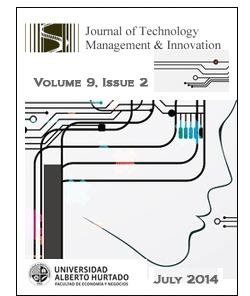Humanitarian Logistics: a Clustering Methodology for Assisting Humanitarian Operations
DOI:
https://doi.org/10.4067/S0718-27242014000200007Keywords:
Humanitarian Logistics, Clusters, Natural Disasters, Preparedness and Response, Procurement of Relief SuppliesAbstract
In this paper, we propose a methodology to identify and classify regions by the type and frequency of disasters. The data on the clusters allow you to extract information that can be used in the preparedness phase as well as to identify the relief items needed to meet each cluster. Using this approach, the clusters are formed by using a computing tool that uses as the input the history data of the disasters in the Brazilian state of Santa Catarina, with a specific focus on: windstorms, hail, floods, droughts, landslides, and flash floods. The results show that the knowledge provided by the clustering analysis contributes to the decision making process in the response phase of Humanitarian Logistics (HL).Downloads
References
ACOSTA, M. Gonçalves, M. and Vidal, M.E. (2011). CAREY: Climatological control of emergency regions. OTM Workshops, Springer-Verlag Berlin Heidelberg. LNCS 7046, p.494–503. DOI:10.1007/978-3-642-25126-9_61. ISSN 0302-9743. ISBN 978-3-642-25126-9.
BALCIK, B. and Beamon, B.M. (2008), Facility location in humanitarian relief. International Journal of Logistics: Research and Applications, 11.2, p.101-121. DOI: 10.1080/13675560701561789
BANDYOPADHYAY, S., (2011).Genetic algorithms for clustering and fuzzy clustering. WIREs Data Mining and Knowledge Discovery1, p.524–531. DOI: 10.1002/widm.47
BEAMON, B.M. (2004), Humanitarian relief chains: issues and challenges, Proceedings of the 34th International Conference on Computers & Industrial Engineering, San Francisco, CA, USA.
BEAMON, B.M. and Kotleba, S.A. (2006a), Inventory management support systems for emergency humanitarian relief operations in South Sudan, International Journal of Logistics Management, 17.2, p. 187-212. DOI: http://dx.doi.org/10.1108/09574090610689952
BEAMON, B.M. and Kotleba, S.A. (2006b), Inventory modelling for complex emergencies in humanitarian relief operations, International Journal of Logistics: Research and Applications, 9.1, p. 1-18. DOI: 10.1080/13675560500453667
CHANG, M., Tseng, Y. and Chen, J. (2007), A scenario planning approach for the flood emergency logistics preparation problem under uncertainty, Transportation Research: Part E, 43.6,p. 737-54. DOI: 10.1016/j.tre.2006.10.013
CHU H. J., Liau, C. J., Lin C.H. and Su, B.S. (2012).Integration of fuzzy cluster analysis and kernel density estimation for tracking typhoon trajectories in the Taiwan region. Expert Systems with Applications, 39.10,p. 9451-9457. DOI: 10.1016/j.eswa.2012.02.114
COPPOLA, D. P. (2011) Introduction to International Disaster Mangement. 2nd Ed. Butterworth-Heinemann. ISBN-10: 0123821746 | ISBN-13: 978-0123821744
DEFESA CIVIL (2013). Available: www.defesacivil.gov.br. [Acessed June,2013]
IBGE (2013) Available: www.ibge.gov.br.[Acessed June,2013]
JAHRE, M. and Jensen, L. M. (2010). Coordination in humanitarian logistics through clusters. International Journal of Physical Distribution & Logistics Management, 40.8/9,p. 657-674. DOI (Permanent URL): 10.1108/09600031011079319
JAHRE, M. and Navangul, A. K. (2011) Predicting the unpredictable – Demand Forecasting in International Humanitarian Response. In: Proceedings of the 23rd Annual NOFOMA Conference. Harstad, Norway, p. 265-281.
KOGAN, J., Nicholas, C. and Teboulle, M. (2006). Grouping Multidimensional Data: Recent Advances in Clustering. Berlin: Springer. ISBN-10 3-540-28348-X Springer Berlin Heidelberg New York; ISBN-13 978-3-540-28348-5 Springer Berlin Heidelberg New York
KOVÁCS, G. and Spens, K. M. (2007). Humanitarian logistics in disaster relief operations. International Journal of Physical Distribution & Logistics Management, 37.2, p.99–114. DOI (Permanent URL): 10.1108/09600030710734820
LI, Bin ; Su, Hongbo ; Chen, Fang ; Li, Shenggong ; Tian, Jing ; Qin, Yuchu ; Zhang, Renhua ; Chen, Shaohui ; Yang, Yongming and Rong, Yuan (2013). The changing pattern of droughts in the Lancang River Basin during 1960–2005. Theoretical and Applied Climatology,111.3 p.401-415. DOI 10.1007/s00704-012-0658-2
LIU, C. ; Kuo, Y. and Chen, C.-W. (2013). Emergency responses to natural disasters using Formosat-2 high-spatiotemporal-resolution imagery: forest fires . Natural Hazards, 66.2,p.1037-1057. DOI 10.1007/s11069-012-0535-4
MEIRIM, H. (2007). Logística humanitária e logística Empresarial, mmrbrasil. Available: www.mmrbrasil.com.br. [Accessed April, 2010].
MITHAL, V., Garg, A., Boriah, S., Steinbach,M., Kumar, V., Potter, C., Klooster, S.A. and CastillaRubio, J.C. (2011). Monitoring global forest cover using data mining. ACM TIST 2.4, p.36. DOI: 10.1007/978-3-642-25126-9
OCHA (2014) Available: http://www.unocha.org/what-we-do/coordination-tools/cluster-coordination [Accessed Jan,2014]
OVERSTREET, R. E., Hall, D., Hanna, J. B., Rainer Jr., R. K. (2011). Research in humanitarian logistics. Journal of Humanitarian Logistics and Supply Chain Management. 1.2, p. 114-131. DOI (Permanent URL): 10.1108/20426741111158421
PORTER, M.E. (1998). Clusters and the new economics of competition. Harvard Business Review,76.6,p. 77-90.
RACE, C., Steinbach, M., Ganguly, A., Semazzi, F.H.M. and Kumar, V. (2011). A knowledge discovery strategy for relating sea surface temperatures to frequencies of tropical storms and generating predictions of hurricanes under 21st-century global warming scenarios. In: CIDU, p. 204–212. . DOI: 10.1007/978-3-642-25126-9
THOMAS, A. (2004). Elevating Humanitarian Logistics. International Aid & Trade Review.
THOMAS, A. (2007). Enabling disaster response. Institute Fritz. Available: http://www.fritzinstitute.org/index.htm. [Accessed June, 2013].
TOMASINI, R. and Van Wassenhove, L. (2009). Humanitarian logistics. Insead Business Press. ISBN-10: 0230205755 | ISBN-13: 978-0230205758
TUFINKGI, P. (2006). Logistik im kontext internationaler katastrophenhilfe: Entwicklung eines logistischen referenzmodells für katastrophenfälle.Ed. Haupt Verlag. Bern. Stuttgart Wien. ISBN 13:378-3-258-07036-0. ISBN 10:3-258-07036-9.
WAN, S. (2012). Entropy-based particle swarm optimization with clustering analysis on landslide susceptibility mapping. Environment Earth Science. 68, p.1349-1366. DOI 10.1007/s12665-012-1832-7
Downloads
Published
How to Cite
Issue
Section
License
Copyright (c) 2014 Journal of Technology Management & Innovation

This work is licensed under a Creative Commons Attribution-ShareAlike 4.0 International License.







